 |
Bradley & Co. Ltd
(Beldray)
Mount Pleasant, Bilston |
 |
7. 1945 to 2005: the products
In outline we can say that after the War the company
continued with general domestic ware, based on steel plate, with a
variety of finishes, especially galvanised. These products
included kettles, baking trays, saucepans, frying pans, buckets, pails,
dustbins and the like. Their watering cans continued in
production. But the brass and copper art metalwares were never
re-introduced after the War.
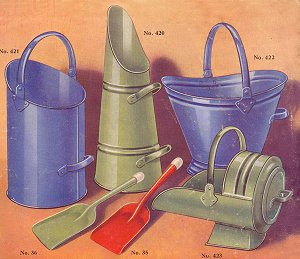 |
The company had to keep up with
changing demands, fashions and materials. It seems to
have done so throughout its life. It was not any sort
of product or design failure which lead to its ultimate
demise.
This undated flyer shows at least
some of the range with a coloured finish of an unspecified
type. |
|
This undated flyer is for binettes
(which are "suitable for holding bread or flour, or can be
used as kitchen tidies or garbage pails). Up to now
they would have been plain galvanised or perhaps japanned
black. But now there are mottled grey, green and blue
finishes - though what the finish is, the flyer does not
say, only that "it cannot scratch", it can be "scrubbed with
hot water and soap" and is "equal to vitreous enamel at much
less cost".
It is possible that some of these
coloured finishes were introduced before the war. If
so, government regulation would have prevented their use
during the war and not allowed their re-introduction until
some years after it. |
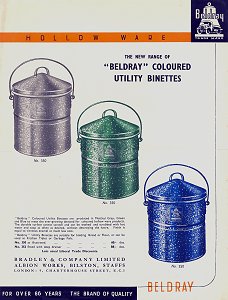 |
Michael Doubleday says that in the immediate post-war
years Hermon Bradley wanted to take the firm in new directions. He
brought in a lot of new people and many of the older senior employees
left. These included Norman Doubleday, the Works Manager, whose
position was taken by George Freeman, who had been his deputy.
It
seems, from the catalogues still extant, that not only did the brass and
copperware fall by the wayside but that gradually many of the company's
old lines fell out of production as new lines took over. These new
lines included things like step ladders but the most notable of them
were ironing boards, which were joined by a range of associated laundry
products. In 1961 the company branched out in to new fields by
producing a modular storage system, the first made in the UK.
In more recent years (some time after Brian Davies left
the firm in 1994) the company moved into safety equipment, such as the
gates you put at the top of the stairs to stop children falling down,
and they produced a wide range of such things.
The old range of products
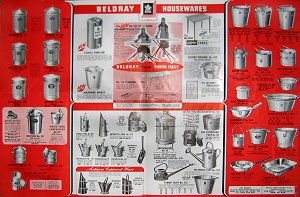 |
This folded flyer (which opens out to about 3ft by 2ft)
can be dated to 1959 and, although ironing boards appear in
pride of place, dustbins, buckets, coal scuttles, watering
cans and the like still appear. The leaflet may not
show the entire range and ladders are absent. |
| One of a series of studio
photographs, presumably taken for advertising purposes.
This dramatically lit cheerful char is using what is
presumably a Beldray bucket.
There is a lot of space above her. This is common in
such photos - it leaves room for the advertising text to be
added. |
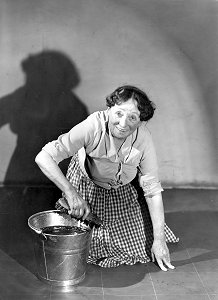 |
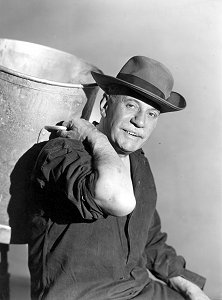 |
A thoroughly unconvincing dustman
sits on a chair with a Beldray dustbin on his back and a
smart hat on his head. The model looks as if his next
job could be as the old colonel drinking whiskey at the
country club. |
| A watering can which still has its
original paper label.
From the Reg Aston
collection. |
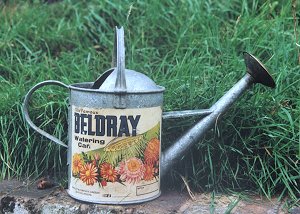 |
The old products were, of course, updated in design,
materials and production methods. Wheelbarrows benefitted in this way.
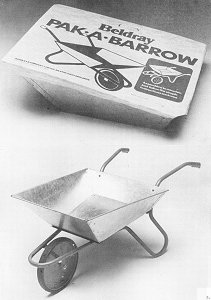 |
Brian Davies says
that this Pak-a-Barrow was added to the range in about
1976. It was sold in the pack shown at the top,
with all the bits loaded into the body. The idea
was to save space for transport and storage and was
aimed at the then burgeoning cash and carry DIY
operations.
|
Storage system
| Mary Southall says: "Up to 1960 a German company
was the only firm producing a storage system. The
Development Section of Bradley's saw the need of a storage
system but in British measurements and not metric. So
in 1961 the company developed the first British modular
storage system and gave it the name 'Spacesaver'."
|
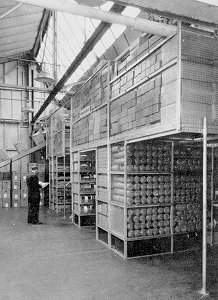 |
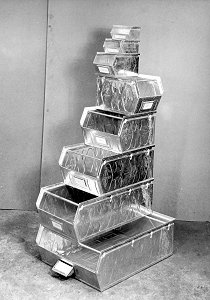 |
"A wide range of new open fronted containers, which can
be self stacked or accommodated in the unit system is now
produced by the firm. This system has been developed
over the past five years with the addition of platforming,
dividers, plastic containers, etc.. This form of
storage is now in use with most of the largest manufacturing
companies in the country". It is not know how long this
apparently successful product was in production.
Although it made use of the company's metalworking skills,
it was of a different size and type to their usual range of
products. |
Ladders
| It is not known when ladders were introduced to the
range but in this brochure of 1975 there are plenty of them,
along with ironing boards, wheelbarrows, dustbins and mop
pails.
No prizes are offered for amusing comments on the style
sense of the bright young things. But how well
acquainted would they have been with mop pails? |
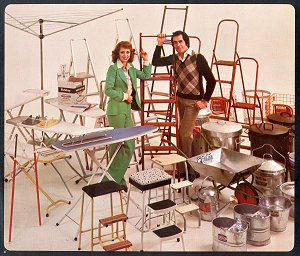 |
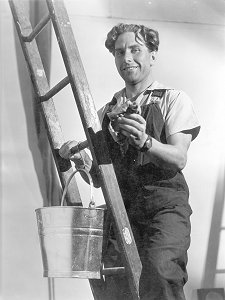 |
A cheeky chappy displays a Beldray
bucket but, oddly enough, he seems to be on a wooden ladder
- and Beldray did not make wooden ladders. Perhaps the
photo was taken before the range was introduced.
|
| Bradleys would have continued to
exhibit at trade and other fairs. This photograph was
taken at an unidentified fair, possibly something like the
Ideal Home exhibition. The stand seems to have
featured lots of ladders. |
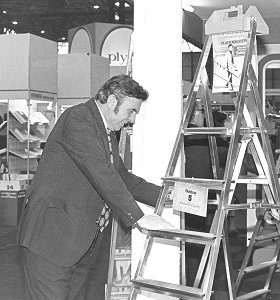 |
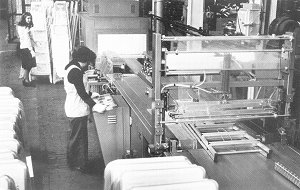 |
A shrink wrapping machine being
used to wrap ladders. |
Ironing Boards
Beldray ironing boards became so widely sold and so much appreciated
that they became an icon of the firm, if not of Bilston. (They
occupied much the same position as the Hill's Hoist does in South
Australia. Though founded much later, Hills have a very similar
sort of manufacturing history and make all sorts of laundry equipment
and accessories. And, of course, Beldray made a rotary clothes
drier (as seen in the 1975 colour photo above), in all but a few
features a Hill's Hoist.
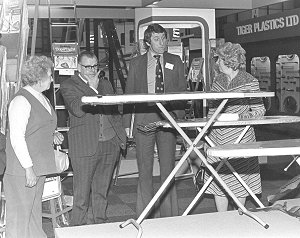 |
Ironing boards on an exhibition
stand. |
According to Mary Southall the first ironing board was made in 1951.
It had fixed legs and a steel top instead of the traditional wooden one.
It was called the Mark 1 and was made exclusively for the Canadian
market, as a result of the then Managing Director, R. Turner Hood, and
going to Canada and getting a contract with a firm called Eatons.
There were several developments of the board up to the Mark 7, which was
the first to have fully adjustable legs and was introduced in 1954-55.
| An ironing board making machine.
Brian Davies says: "Enormous numbers of items were
produced and new machinery was constantly being installed.
Here are two multi-spot welding machines, by the British
Federal Welding and Machine Co. of Dudley, which we put in
to increase production rates of the famous ironing boards". |
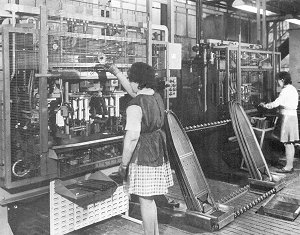 |
Then in 1960 the contract with Eatons "fell through" for reasons not
specified. So Bradley's then developed an entirely new table
called the Five Star which was adjustable to 12 different heights.
It sold in large quantities at home and abroad. At the same time
the Europa was introduced which had a retractable well for the iron.
From then on development appears to have been continuous and when Ms
Southall wrote, in about 1967, she declared that there were nearly fifty
different kinds, some of which were made for other companies under their
brand names.
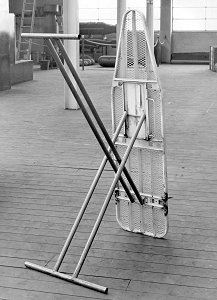 |
A photo of an upended ironing
board, without the board covering. Presumably this
photo was taken in the factory and was intended to show the
height adjustment mechanism. |
| An ironing board, with a sleeve
board, shown in a more natural position. |
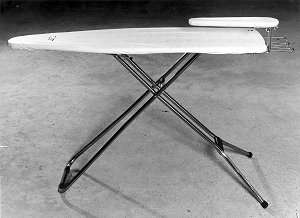 |
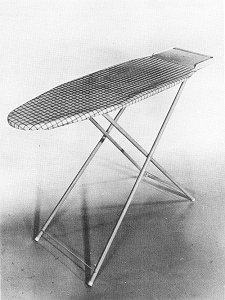 |
The Ideal. This one had a
chipboard top instead of a metal one. |
| Beldray had many products
connected with laundry work, from the old galvanised wash
tubs to clothes airers to this "Ironsto" which you could
screw to the wall and use it to store even a hot iron.
Thanks to Vin Callcut for finding this item. |
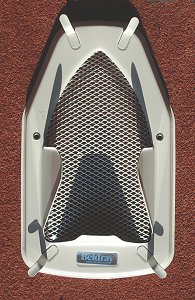 |
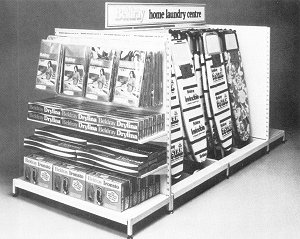 |
A point of sale display stand,
designed and made at Beldray. |
| A child's ironing board, complete
with a Morphy Richards pretend iron which had a suction plug
on the cable end to fix to the wall, just like the real one. |
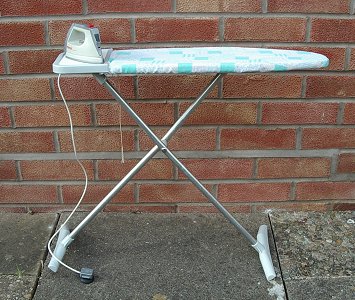 |
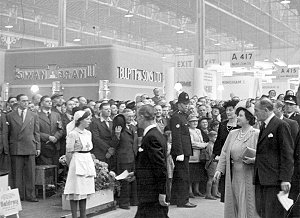 |
A photo, probably taken at an
Ideal Home exhibition, shows the Beldray stand on the far left, falling
under the gracious gaze of Her Majesty Queen Elizabeth. Goodness
knows what the relevance of the nurse is. |
An employee's clocking in check. Aluminium. 50mm diam.
Reverse blank.
Thanks to Jaap Arriens. |
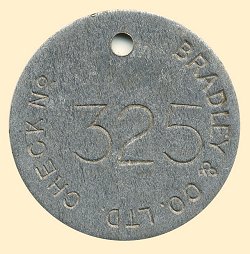 |
|

























